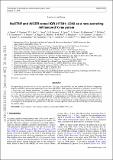NuSTAR and NICER reveal IGR J17591–2342 as a new accreting millisecond X-ray pulsar
Author(s)
Sanna, A.; Ferrigno, C.; Ray, P. S.; Ducci, L.; Jaisawal, G. K.; Enoto, T.; Bozzo, E.; Altamirano, D.; Di Salvo, T.; Strohmayer, T. E.; Papitto, A.; Riggio, A.; Burderi, L.; Bult, P. M.; Bogdanov, S.; Gambino, A. F.; Marino, A.; Iaria, R.; Arzoumanian, Z.; Gendreau, K. C.; Guillot, S.; Markwardt, C.; Wolff, M. T.; Chakrabarty, Deepto; ... Show more Show less
Download1808.10195.pdf (486.8Kb)
OPEN_ACCESS_POLICY
Open Access Policy
Creative Commons Attribution-Noncommercial-Share Alike
Terms of use
Metadata
Show full item recordAbstract
We report the discovery by the Nuclear Spectroscopic Telescope Array (NuSTAR) and the Neutron Star Interior Composition Explorer (NICER) of the accreting millisecond X-ray pulsar IGR J17591-2342. Coherent X-ray pulsations around 527.4 Hz (1.9 ms) with a clear Doppler modulation were detected. This implies an orbital period of ∼8.8 h and a projected semi-major axis of ∼1.23 lt-s. With the binary mass function, we estimate a minimum companion mass of 0.42 M, obtained assuming a neutron star mass of 1.4[subscript ⊙] and an inclination angle lower than 60°, as suggested by the absence of eclipses or dips in the light curve of the source. The broad-band energy spectrum, obtained by combining NuSTAR, swift and INTEGRAL observations, is dominated by Comptonisation of soft thermal seed photons with a temperature of ∼0.7 keV by electrons heated to 21 keV. We also detect black-body-like thermal direct emission that is compatible with an emission region of a few kilometers and a temperature compatible with the seed source of Comptonisation. A weak Gaussian line centred on the iron Kα complex can be interpreted as a signature of disc reflection. A similar spectrum characterises the NICER spectra, which was measured when the outburst faded. Key words: accretion, accretion disks / stars: low-mass / pulsars: general / stars: neutron / X-rays: binaries
Date issued
2018-09Department
Massachusetts Institute of Technology. Department of PhysicsJournal
Astronomy & Astrophysics
Publisher
EDP Sciences
Citation
Sanna, A., C. Ferrigno, P. S. Ray, L. Ducci, G. K. Jaisawal, T. Enoto, E. Bozzo, et al. “NuSTAR and NICER Reveal IGR J17591–2342 as a New Accreting Millisecond X-Ray Pulsar.” Astronomy & Astrophysics 617 (September 2018): L8. © 2018 ESO 2018
Version: Original manuscript
ISSN
0004-6361
1432-0746